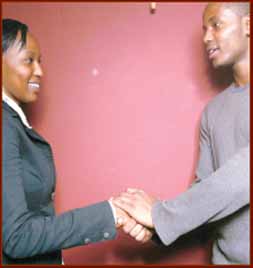|
|
That magical moment brought the country back from the brink, ending months of turmoil and weeks of negotiation after the disputed poll results. Indeed the mere signing of the agreement meant to usher in a new dawn of reconciliation and power-sharing would have been worthless had the two leaders not shaken hands in public.
According to Dr Ouko, within diplomatic circles a handshake is a symbol of unity. It denotes the coming to an agreement, consensus or compromise at the end of a confrontation or discussion.
"This is a deeply entrenched tradition and even the fiercest or most critical of protagonists and foes cannot run away from it.
|
|
The symbolic gesture is popular, especially among presidents or corporate bigwigs. Whenever they pose for photographs, they prefer to be captured shaking hands," says Dr Ouko.
For many people though, the handshake goes beyond a mere formality or photo opportunity.
From a sociological perspective, the body language related to the gesture provides an insightful view into the personalities of those on either end of the handshake. Interaction is indeed stimulated by handshakes. In such instances, shaking hands serves the function of being a form of expressing greetings, hence one essentially acknowledges awareness of the other’s presence after making contact.
As is the case with many forms of communication, greeting habits are highly cultural or situation-specific and may change within a given context, depending on social status and the nature of relationship. And although greetings can be expressed both verbally and physically, they often involve a combination of the two. But the most common reason for shaking hands is that of making introduction, whether in an informal or formal setting.
"A handshake can also be used at the start and end of a meeting. For many people, especially those not acquainted, mere verbal introduction or just saying ‘hello’ does not make the same impression as reaching out to someone and shaking their hand," says Dr Ouko.
The sociologist attributes the acceptance of the gesture to what he refers to as the principle of "folkways".
He explains: "These are social rules which however, are not enforceable. Those that can be enforced are described as norms. The latter are unspoken rules that the society is expected to abide by and embrace without raising questions. They have been transferred from one generation to another and have gradually acquired the status of being popular social habits," he notes. A typical scenario is when we meet someone, at times even a stranger, and stop to greet them. Few of us ever stop to think about why we are doing it.
The handshake is believed to have began in most communities as a sign of acknowledgment that two or more individuals knew each other. And in the process, the gesture also encouraged bonding, especially because pleasantries would also be exchanged. The tradition of shaking hands is traced back to days of the ancient wars – when those fighting would extend their hands to those in the same group as a sign of familiarity and belief in the same cause.
Though it is difficult to peg origins of the handshake to a specific time frame, the gesture has evolved through the centuries. Nonetheless, some anthropologists have made assertions that shaking hands may have started off with the Aborigines who supposedly had a way of greeting people with facial expressions or at times with a handshake.
"They would contort their faces to reflect familiarity or failure to recognise an individual," says Dr Ouko. But in Africa, the culture of brotherhood or age groups, as primary cultural support system encouraged people to hug, hold or shake hands.
Dr Ouko points out that often the decision on whether or not to shake hands hinges on numerous reasons or circumstances, just as preference varies on the basis of different individual’s perceptions.
"At the beginning of courtship for those looking out for marriage or long term partners, the love birds tend to shake hands a lot. It serves as an indicator of their potential interest in getting to know each other," says the sociologist.
Shared bond
As the friendship grows and the pair is drawn closer by deeper knowledge or understanding of each other, the initially formal handshakes are bound to subconsciously begin lingering a bit longer. And much later, as the shared passion intensifies, shaking hands disappears altogether as the couple move on to a different level that involves actions like hugging or kissing as a form of greeting.
However, after marriage it becomes awkward for spouses to shake hands because by then a couple has developed intimate, internalised—hence almost impulsive—communicative gestures.
Handshakes are also used as a way of marking out the emotional distance between individuals depending on the nature of the bond shared. "It does not make much sense, for instance, to keep on shaking hands with a girlfriend, husband or even your child because you relate to the individuals at a different, hence deeper level rather than a casual one," says Dr Ouko.
Nonetheless, although it is a simple gesture, the handshake symbolises solidarity between communities or individuals. It can also make a great difference as a determining factor in job interviews and social gatherings. All it takes is a firm handshake, while looking straight in the other person’s eye – to effectively make a first, and yet lasting impression.
Source: The Standard
|
PALM READING | PALMISTRY
 Find a Palmist in Kenya! Find a Palmist in Kenya!
Related sources:
The power of handshake
Doctor diagnosed tumour by shaking a man’s hand
A Handshake is less healthier than a kiss
What does your Handshake say about you?
Give a firm Handshake, and hide yourself
HANDS IN THE NEWS
|
